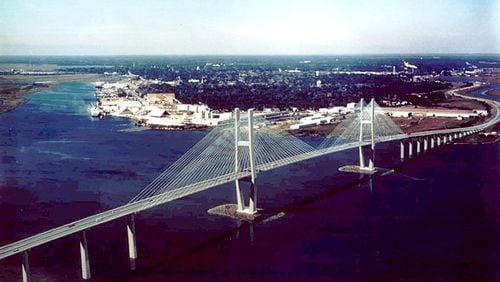Originally published April 7, 2003
BRUNSWICK — By the time Edwin Fendig realized the African Neptune was headed for the Sidney Lanier Bridge, it was already too late.
“Hard left,” Fendig commanded of the helmsman, who moments earlier had turned the rudder the wrong way as the ship headed out of harbor.
Fendig was the pilot in charge of guiding the 11,000-ton cargo ship to sea through the lift bridge’s narrow opening. Fendig barked from the dark wheelhouse: “Full astern.”
The emergency bell sounded. The anchor dropped. The turbine engines churned to reverse.
The ship slowed in the black water, but it would not stop. Fendig blasted the steam whistle, desperate to warn spectators who were parked or standing on the bridge above. He braced for impact, his hands firmly against the bulkhead.
As if in slow motion, the massive bow merely nudged the bridge support, calmly buckling its concrete and steel. Three sections of road crashed into the salt water.
Fendig watched as a truck full of oranges slipped off the bridge and into the sea. He saw the driver pull himself onto the floating trailer.
Ten other people, some still sitting in their cars waiting for the bridge to be lowered, fell into the sea and drowned.
Fendig has lived with that night for 30 years. “If we had had another minute, she’d have stopped,” he said.
Today, politicians and community leaders will gather in this coastal city to open the new Sidney Lanier Bridge, a majestic $110 million cable-stayed structure spanning the marshes of Glynn County. The massive bridge — one of the largest of its kind in the world — will replace the old Sidney Lanier Bridge and serve as the new gateway to the Port of Brunswick.
Gov. Sonny Perdue and other state officials will be on hand to sing the bridge’s praises as an economic boon and new symbol of Georgia pride.
The bridge is key to helping Brunswick and the state retain the world shipping market it now captures, and it will play a vital role in developing new business. County and city officials expect the bridge to help protect and build the area’s $800 million a year tourism industry.
Local residents are excited that they will no longer have to wait for the bridge to be raised when cargo ships pass through the shipping channel below.
A native of St. Simons Island, Fendig, 75, welcomes those benefits. But more than anything, he takes comfort in knowing the end is near for the 47-year-old bridge that has haunted shippers ever since that fatal night in 1972 when innocent lives were lost.
Push for a new bridge
Despite the deaths, the bridge’s demise didn’t come quickly. It took 15 years and a second crash to stir community support for a replacement.
In 1987, a second ship grazed the bridge’s lift tower. No one was killed, but the span was knocked out of commission for months.
Woody Woodside, president of the Brunswick-Golden Isles Chamber of Commerce, said restaurants, hotels and shops suffered. The bridge closing had severed U.S. 17, the main artery linking the area’s barrier islands. Instead of a 3-mile drive between the St. Simons Island and Jekyll Island causeways, residents and tourists had to drive more than 17 miles to get to the other side of the bridge.
Woodside helped organize a meeting of congressional, state and local politicians in late 1987. The mood was generally pessimistic. A new bridge would cost millions, and not everyone was convinced it was needed. Proponents said a new bridge was necessary for the area’s important tourism industry.
“It might be like climbing Mount Everest, but someone had to take the first step,” Woodside said.
Behind the scenes, Fendig and the shippers pushed hard, telling stories of their close calls with the bridge and dredging up memories of the 1972 accident.
After years of political maneuvering, former U.S. Rep. Lindsay Thomas cajoled Congress into declaring the bridge an “obstruction to navigation” because of its outdated size and dangerous alignment.
Navigating the tight opening had become increasingly dangerous for white-knuckled seamen.
“With the growing port traffic and the dramatically larger size of ships calling at the Port of Brunswick, I have no doubt there will be more accidents in the future,” Thomas said in a July 10, 1990, speech to the U.S. House.
The port also was missing business because the larger ships had trouble entering the port.
“You’ve got a speed bump right there in the middle of the harbor,” Fendig said.
Under federal law, the bridge’s new designation as an obstacle obligated the U.S. Coast Guard to split the cost of a new bridge with the state. It would take six more years to design and fund the new Sidney Lanier Bridge. Engineers and contractors had to work around the fragile marsh habitat, and state leaders had to fight for money in Congress.
The state broke ground for the new bridge April 14, 1997. Problems continued. The bridge was supposed to be completed within four years. Instead, it took six.
Construction delays
The longest delay came in 1999, when a massive steel mold used to form the bridge’s main concrete span broke loose and shattered on a rock island. A replacement was recast in Italy. Work resumed six months later.
Other delays were caused by the bridge’s complicated design, drawn up by the same engineer who created Savannah’s Talmadge Memorial Bridge.
State Department of Transportation engineer Lisa Sikes, project manager for the new bridge, said the construction was a challenge.
“This contractor did stump his toe a few times,” Sikes said of Miami-based Recchi-GLF, which had to redo portions of the bridge work. “There’s plenty of pitfalls in this kind of construction.”
Delays have made the bridge a subject of ridicule among locals. Uncertainty causes a few to wonder whether the bridge is even safe. But most Brunswick area residents express a sense of relief that the bridge will finally open. The state DOT held an open house for the bridge Saturday in conjunction with a rally to support troops from nearby Fort Stewart at war in Iraq.
On Wednesday, the bridge was a topic of conversation between lunch tables at Mack’s Bar-be-que Place on U.S 17, a couple of miles from the port. Owner Mack Wilson expects such interest in the bridge to draw curious tourists from I-95, the Atlantic Coast’s interstate spine.
“They can come right by here and get back on I-95,” he said. “It should be a really good boost for us.”
Tourism accounts for about 60 percent of the local economy, according to the Chamber of Commerce. Manufacturing, the port and the Federal Law Enforcement Training Center in Brunswick account for most of the rest.
Bill Dawson, general operations manager for the Port of Brunswick, said the new bridge’s “unlimited” horizontal clearance will allow the facility to keep its current customers happy. Many are forced to bring in ships at less than full capacity to make the old bridge’s 250-foot-wide clearance. That increases shipping costs for industries that use the port.
Old bridge will go
There is also potential for new shipping business. Dawson expects to move 300,000 new cars --- everything from Porsches to Hyundais --- through the port this year. At Colonel’s Island, where the autos are stored and processed for shipment to dealers, there is room to expand. Removing the old bridge will be completed next year, and the shipping channel will be dredged 6 feet deeper and to a width of 400 feet under the bridge. At that point, the port will be able to accommodate the newest class of super car-carrying ships.
“You’re trying to allow for future growth without a noose around your neck,” Dawson said.
Fendig also looks forward to when Brunswick blossoms into what he said will be a “world-class” port. He retired from piloting cargo ships a few years ago, but Fendig still helps manage the local pilots’ association and is one of the port’s biggest boosters.
After the ‘72 crash, a Coast Guard investigation cleared Fendig of any negligence and determined the helmsman’s wrong rudder turn was the primary cause of the collision. Lawsuits followed. Fendig said it was years before he could talk about the accident.
Last week, demolition crews prepared to dismantle the old bridge’s clunky green lift span, which will be floated away on a barge within weeks.
Fendig hopes to get his tugboat involved in towing the bridge out to sea. “If we get to put a line on it,” he said, “I’m going to tie the knot.”
News researcher Sharon Gaus contributed to this article.
About the Author






